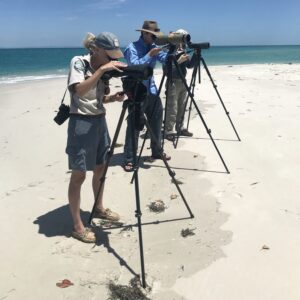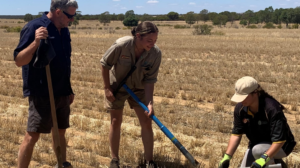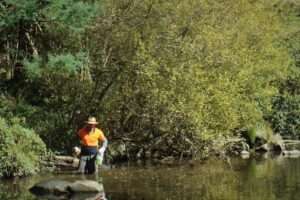National NRM update for February 2021. This update represents just a handful among the hundreds of NRM projects going on across Australia, which are made possible through funding from the Australian Government’s National Landcare Program and from respective State governments.
 Bird experts from Queensland Wader Study Group and Gold Coast Shorebirds recently visited over 117 sites along the coast of South East Queensland to count the many thousands of migratory and other shorebirds that visit the region or live there all year round. This is the first time in over 10 years that such a comprehensive survey of shorebirds has taken place, and the data gained will inform management and conservation of the Moreton Bay Ramsar Site and other areas vital to these internationally important species.
Bird experts from Queensland Wader Study Group and Gold Coast Shorebirds recently visited over 117 sites along the coast of South East Queensland to count the many thousands of migratory and other shorebirds that visit the region or live there all year round. This is the first time in over 10 years that such a comprehensive survey of shorebirds has taken place, and the data gained will inform management and conservation of the Moreton Bay Ramsar Site and other areas vital to these internationally important species. Drought conditions affecting parts of the Northern Territory over 2018-2020 prompted industry to explore ways of better managing drought vulnerable rangelands to sustain their health and productivity, and build resilience in pastoral enterprises.
Drought conditions affecting parts of the Northern Territory over 2018-2020 prompted industry to explore ways of better managing drought vulnerable rangelands to sustain their health and productivity, and build resilience in pastoral enterprises.
Territory NRM (TNRM) is working to raise industry awareness about drought and climate risks, and potential mitigation strategies. With support from the Australian Government’s ‘Future Drought Fund’ and in partnership with Cibo Labs and project partners (NT Cattlemen’s Association and Department of Industry Trade and Tourism), TNRM will be rolling out an innovative new web based platform that allows producers to plan stocking rates and manage grazing lands based upon accurate knowledge of current forage resources. These new technologies will change how producers manage grazing lands for optimal efficiency and sustainability and to mitigate the impacts of increasing climatic variability.
 The 2020 bushfires in NSW's Upper Murray not only devastated bush and farmland - waterways like Mannus Creek were also severely affected by runoff and bushfire sediment, decimating aquatic life. Recently, 2,500 baby Macquarie perch were returned to Mannus Creek to help rebuild the population. Mannus Creek contains one of four remaining populations of Macquarie Perch in NSW. DPI Fisheries NSW and Charles Sturt University, with support from Murray Local Landcare Services have been working to improve habitat conditions for Macquarie perch and reduce threats such as pest fish species. Watch this video for highlights from the release https://www.youtube.com/watch?v=cfDPrHRdRIw
The 2020 bushfires in NSW's Upper Murray not only devastated bush and farmland - waterways like Mannus Creek were also severely affected by runoff and bushfire sediment, decimating aquatic life. Recently, 2,500 baby Macquarie perch were returned to Mannus Creek to help rebuild the population. Mannus Creek contains one of four remaining populations of Macquarie Perch in NSW. DPI Fisheries NSW and Charles Sturt University, with support from Murray Local Landcare Services have been working to improve habitat conditions for Macquarie perch and reduce threats such as pest fish species. Watch this video for highlights from the release https://www.youtube.com/watch?v=cfDPrHRdRIw
 For Wheatbelt NRM’s Noongar Budjar Rangers, a healthy country and healthy soils are of the utmost importance. They are now expanding their skillset in this area by participating in soil sampling at demonstration farm sites. Up to 17 local Aboriginal people are now employed through the program, empowering cultural custodians of the Wheatbelt to bring health back to country through activities including seed collection, revegetation and soil sampling. For more information on the soil trial and Aboriginal involvement in this program, visit https://wheatbeltnrm.org.au/whats-happening/news/aboriginal-nrm/noongar-budjar-rangers-grow-skills-country-and-farm
For Wheatbelt NRM’s Noongar Budjar Rangers, a healthy country and healthy soils are of the utmost importance. They are now expanding their skillset in this area by participating in soil sampling at demonstration farm sites. Up to 17 local Aboriginal people are now employed through the program, empowering cultural custodians of the Wheatbelt to bring health back to country through activities including seed collection, revegetation and soil sampling. For more information on the soil trial and Aboriginal involvement in this program, visit https://wheatbeltnrm.org.au/whats-happening/news/aboriginal-nrm/noongar-budjar-rangers-grow-skills-country-and-farm
 The far upper reaches of Victoria's Agnes and Franklin rivers are inaccessible to most, but these waterways have been the focus of the West Gippsland Catchment Management Authority's headwater willow control program. This program aims to remove willows high in the catchment so that they can’t re-establish downstream. Willows can change stream and river courses, choke up the middle of waterways and take over from native vegetation - resulting in is less available habitat for native animals and reduced waterway biodiversity.
The far upper reaches of Victoria's Agnes and Franklin rivers are inaccessible to most, but these waterways have been the focus of the West Gippsland Catchment Management Authority's headwater willow control program. This program aims to remove willows high in the catchment so that they can’t re-establish downstream. Willows can change stream and river courses, choke up the middle of waterways and take over from native vegetation - resulting in is less available habitat for native animals and reduced waterway biodiversity.
Image credit: Michael Maconachie
The Brindabella Midge Orchid is a unique plant only found in Namadgi National Park. To protect its future, ACT NRM have developed an action plan to maintain a healthy wild population in the ACT. Their most recent progress report shows that the population is stable and habitat threats have been managed effectively. They are also building a seed bank in partnership with the Australian National Botanic Gardensto preserve the species and learn more about it. This research will be increasingly important to help prevent the extinction of this special species.
Read the full implementation progress report at https://www.environment.act.gov.au/__data/assets/pdf_file/0011/576551/Brindabella_Midge_Orchid_Action_Plan_-_Combined.pdf
 District staff from SA's Murrylands and Riverlands Landscape Board recently conducted river surveys from Blanchetown to Murray Bridge searching for aquatic weed infestations.
District staff from SA's Murrylands and Riverlands Landscape Board recently conducted river surveys from Blanchetown to Murray Bridge searching for aquatic weed infestations. Staff from WA's Peel Harvey Catchment Council (PHCC), along with landholders who have been involved in a 'Numbat Neighbourhood' project took part in the recent release of 11 numbats into Dryandra Woodland. The numbats came from the Perth Zoo and Department of Biodiversity, Conservation and Attractions (DBCA's) Breed for Release program and will be a great boost for the local numbat population. The numbats had previously been fitted with radio tracking collars and DBCA will monitor these individuals to gain important information.
Staff from WA's Peel Harvey Catchment Council (PHCC), along with landholders who have been involved in a 'Numbat Neighbourhood' project took part in the recent release of 11 numbats into Dryandra Woodland. The numbats came from the Perth Zoo and Department of Biodiversity, Conservation and Attractions (DBCA's) Breed for Release program and will be a great boost for the local numbat population. The numbats had previously been fitted with radio tracking collars and DBCA will monitor these individuals to gain important information. February 2 was World Wetlands Day - which this year celebrates its 50th year. NRMs from across Australia highlighted the great work they are doing in many of Australia's 66 Ramsar-listed wetlands.
February 2 was World Wetlands Day - which this year celebrates its 50th year. NRMs from across Australia highlighted the great work they are doing in many of Australia's 66 Ramsar-listed wetlands.In southern Tasmania, home to four Ramsar wetlands, NRM South is progressing work at Moulting Lagoon-Apsley Marshes. Working with project partners the Tasmanian Land Conservancy, Nature Glenelg Trust, the Tasmanian Aboriginal Centre and local landholders, project activities include weed control, using fencing to restrict stock and vehicle access and native vegetation restoration.
